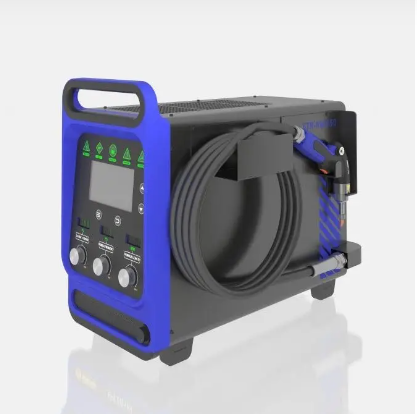As industries continue to demand faster, cleaner, and more precise welding solutions, portable laser welding machines have emerged as a game-changing technology. Their flexibility, compact design, and ease of use make them suitable for a wide range of on-site and workshop applications. But one key question remains for businesses considering this investment: what materials can be welded using portable laser welding machines?
Thanks to innovations in fiber laser technology and real-time control systems, these machines can weld not only common metals but also materials that are traditionally challenging to join with conventional methods. In this blog, we’ll explore the various material types compatible with portable laser welding machines and how these capabilities can enhance your production or repair operations.
Core Material Categories for Laser Welding
Stainless Steel
One of the most commonly welded materials using portable laser welding machines is stainless steel. Whether it's 304, 316, or other grades, stainless steel responds well to the high-energy density and narrow heat-affected zone of laser beams. Laser welding produces minimal spatter, clean seams, and superior penetration—all while preserving the corrosion-resistant properties of the alloy.
This makes portable systems ideal for stainless steel applications in food processing equipment, medical devices, and structural fabrication.
Carbon Steel
Carbon steel is another material that’s highly compatible with portable laser welding machines. Even low- and medium-carbon steels can be effectively joined with proper control over heat input and shielding gas. The key advantage here is minimal thermal distortion compared to arc welding or TIG methods.
Portable systems make it possible to perform rapid, high-quality welds on automotive frames, machinery parts, and industrial equipment without moving the workpiece.
Non-Ferrous Metals
Aluminum and Its Alloys
Aluminum has traditionally been considered a challenging material to weld due to its high thermal conductivity and oxide layer. However, modern portable laser welding machines equipped with higher power outputs and optimized waveforms can now weld aluminum with excellent results.
From aluminum doors and window frames to battery enclosures and marine parts, portable laser welders handle both thin and thick sections with reduced porosity and improved joint strength.
Copper and Copper Alloys
Copper’s reflectivity and conductivity have long posed difficulties in welding. But with recent advancements in beam control and modulation, portable laser welding machines can now tackle pure copper and its alloys with precision.
These capabilities are particularly useful in electrical industries where copper is a common material in connectors, terminals, and busbars.

Exotic and High-Value Materials
Titanium
Titanium welding requires extreme cleanliness and precise heat management. Portable laser welding machines provide both, making them ideal for aerospace, medical implants, and high-end bike frame fabrication.
The laser beam’s focused energy allows for deep penetration and minimal contamination, especially when used with proper shielding gas environments like argon.
Nickel-Based Alloys
Used in aerospace engines, power plants, and chemical processing, nickel-based alloys demand strong, defect-free welds. Portable laser systems offer high energy density and excellent joint control, ensuring that these critical components meet performance and durability standards.
Even complex geometries and tight spots can be welded with precision using handheld laser systems.
Special Application Materials
Galvanized Steel
Galvanized materials often lead to issues like porosity and zinc vaporization when using traditional welding methods. With portable laser welding machines, heat input can be tightly controlled, reducing spatter and ensuring better fusion through the zinc coating.
These features are especially beneficial for automotive repair and HVAC fabrication where galvanized parts are common.
Dissimilar Metals
Joining different metals, such as stainless steel to aluminum or copper to brass, typically involves complex welding setups. Portable laser welding machines offer focused energy control that can be fine-tuned for both metals, allowing for successful dissimilar joints with reduced intermetallic formation.
This opens new possibilities in hybrid part design and repair, particularly in custom fabrication and prototyping.
Why Material Compatibility Matters
Broader Application Range
When a portable laser welding machine can handle multiple materials, it opens up diverse applications—structural welding, decorative joins, repair work, and electronics assembly. This versatility maximizes the return on investment and minimizes the need for multiple specialized tools.
Reduced Training and Setup Time
Laser welding requires less operator skill than traditional techniques. With pre-set material profiles and intuitive interfaces, even non-specialists can weld complex joints across a variety of materials with minimal training.
This means you can deploy the same machine across departments or job sites, increasing workflow efficiency.
FAQ
Can portable laser welding machines weld thick materials?
Yes, many modern systems can weld materials up to several millimeters thick, especially stainless steel and aluminum, depending on the machine’s power output.
Do I need different settings for each material?
Yes. Each material requires specific parameters such as power, speed, and shielding gas. Many machines include preset programs for common materials to simplify this.
Are laser welds as strong as traditional welds?
In most cases, laser welds are cleaner, deeper, and structurally sound—often outperforming TIG or MIG in tensile and fatigue strength when set up correctly.
Is post-weld cleaning necessary?
Often not. Laser welding produces minimal oxidation and virtually no slag, so parts may require little to no post-processing, depending on the application.
 EN
EN
 AR
AR
 FR
FR
 DE
DE
 JA
JA
 KO
KO
 RU
RU
 ES
ES


